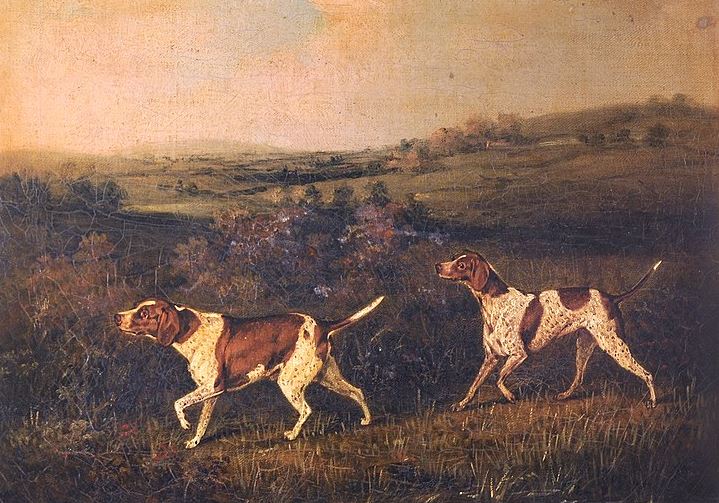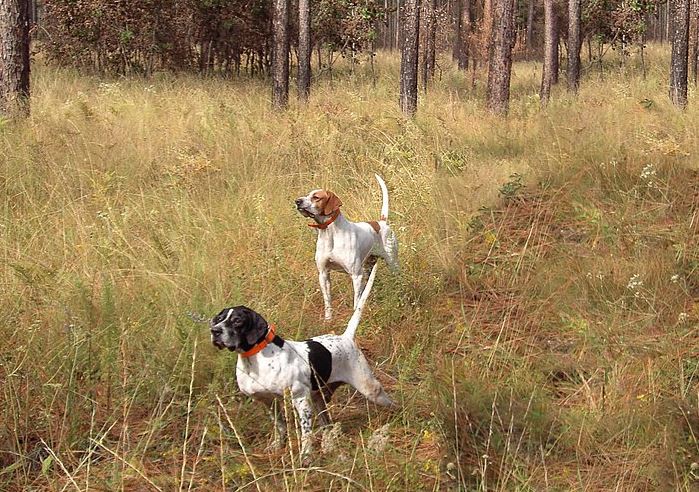When thinking of hunting dogs, the pointer is probably the first one that comes to mind. Because of the visual cues they convey when spotting downed prey, these pups are frequently used in cartoons to portray hunting dogs.
If you’re unfamiliar with the term “pointing,” it refers to a dog breed that tracks a prey item’s scent and then instinctively freezes once it has found its quarry. The dog’s body stiffens, holding one paw upwards, the tail turns upwards, and the nose zeroes in towards the scent in the typical pointing position.
They’re not just great working animals; they’re also great pets. While they are a high-energy breed, they are just as loving and affectionate as a Golden Retriever or a Labrador, two other hunting breeds commonly kept as companion animals.
Because pointers aren’t as common as the other two dogs, you might not be as familiar with them as you may be with their cousins. That’s fine because this guide will teach you all you need to know about these adorable mutts.
Here are some pointer dog characteristics to be aware of.
About the Breed
The pointer is the pinnacle of canine grace and power. The breed’s name reflects its job specification: pointers point game birds and have done so for centuries. The energetic pointer makes an excellent runner’s companion.
Pointers, the undisputed aristocrats of the sporting world, carry themselves confidently and are capable of great agility and speed. The coat comes in various colors, both solid and patterned, but as the breed’s devotees say, an excellent pointer can’t be a bad color. A large male pointer can weigh up to 75 pounds and stand 28 inches tall; a small female can stand 23 inches tall and weigh as little as 45 pounds.
The Pointer’s History
The origin of the pointer is unknown. However, one popular theory holds that the breed is descended from Spanish pointers who arrived in England in the 1700s. Setters, foxhounds, bloodhounds, and greyhounds were added to the mix by English breeders.
As a result, a devoted hunting dog who was agile and swift was created. Pointers were used in tandem with hounds by hunters. The pointers would locate and then point to the prey using their bodies, and the hounds would start moving in to capture it. Pointers are said to exhibit this hunting instinct as early as two months of age.
Pointers were first registered in the United States in 1878, and the American Kennel Club formally recognized them in 1884, when it was founded. Pointers are still being used for hunting today. They also perform well as search-and-rescue dogs and service and therapy dogs.
The Temperament of a Pointer
The temperament of a pointer is an important aspect of their personality and one of the reasons why people adore them. It’s critical to understand whether your pointer’s temperament meshes with the dynamics of your family.
Living with a pointer is both challenging and enjoyable. Pointers are self-sufficient and strong-willed. They delight in spending time with their humans and having a great time. It’s critical to train them and exercise to get the most out of their personalities.
These rather sweet and rambunctious creatures combine the best of both worlds. They can provide you with the thrill and excitement of an active lifestyle while offering you the comfort and calm of a day on the couch. Their temperament is not as simple as it appears, and understanding the dynamic nature and origin of the pointer’s personality can go a long way toward assisting an owner.
Popular Pointing Breeds
You can find more information about the temperament and history of popular pointing breeds here.
English Pointer
The English pointer is frequently referred to as a pointer. Despite its origins in the 17th century, the dog breed took shape in the following century. The popularity of these dogs grew in parallel with the increase of the sport of gunning down birds in flight in England.
English pointers are now recognized as one of the most hardworking, versatile, and popular pointing breeds. They excel in field trials, but their ambition and dynamism also allow them to excel in dog sports such as canicross, agility, and obedience. English pointers are loyal, loving, and sweet-tempered at home.
Bracco Italiano
The Bracco Italiano, also recognized as the Italian pointer, can be traced back to the 5th century and is known as the “Italian hound.” They are among Europe’s oldest breeds of the pointer. In the early twentieth century, a dedicated breeding program used two Bracco varieties, one from the Lombardy region of Italy and the other from the Piedmont region of Italy, to help restore their numbers.
The Bracco is known for its dependability in the field, but it is more docile at home than most other pointing breeds. They are gentle and affectionate dogs who form deep relationships with their family members.
The breed is loud and prone to drooling. They’re also still uncommon in North America.
English Setter
The English setter is the most well-known of the three silky-coated setters that originated in the United Kingdom. This breed, like the Bracco Italiano, has a long history.
You can find dogs resembling this setter in 15th-century art. In the 18th century, these dogs became popular among owners of grand English estates who enjoyed hunting.
Although considered a pointing breed, these dogs, like their relatives the Irish setter and the Gordon setter, were originally developed to lay to “set” when they identified their quarry. The breed is noticeable for its calm demeanor and enjoys the company of gentle kids and other dogs. Although English setters still require a lot of exercises, they are often more calm around the house than other pointing breeds.
Brittany
The Brittany, also known as a spaniel, is a pointing breed. These dogs originated in the northern region of Brittany around the 17th century. This adaptable hunting breed is compact, medium-sized canines.
These canines are in high demand due to their abilities, size, and temperament. They get along well with children and other dogs. A Brittany is a sensitive soul who suffers from separation anxiety, but they are eager to please and respond extremely well to peaceful and positive training techniques.
German Shorthaired Pointer
Germany is renowned for its devotion to the training of skilled hunting dogs. According to some experts, they are the most capable and versatile all-around hunting dogs.
Thie German shorthaired pointer was created by crossing Spanish and English pointers with the now-extinct German bird dog. By the late nineteenth century, the dog had an official studbook and was imported to other countries.
According to the AKC, this breed is the most widely known pointing dog in the United States and among the top ten most popular breeds. GSPs are happy, intelligent, eager to please, and affectionate. These dogs have webbed feet and a strong affinity for water. A close relative is the German wirehaired pointer.
While not as well-known as any other hunting dogs, pointers are equally capable as their more well-known counterparts. If you carry one home, don’t be shocked if you become a lifelong fan of the breed, as these puppies can steal your soul from the moment you meet them.


